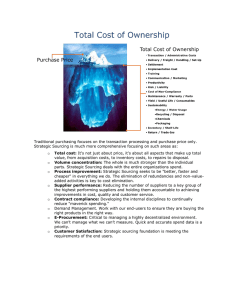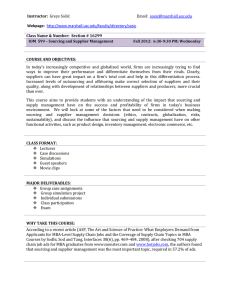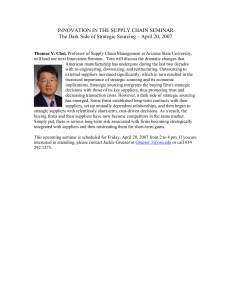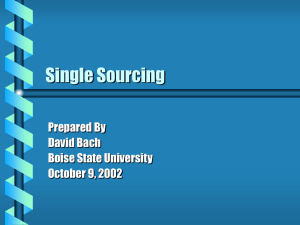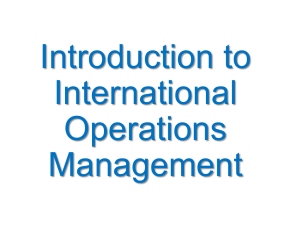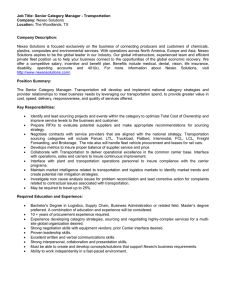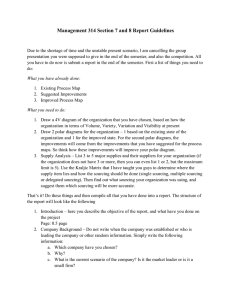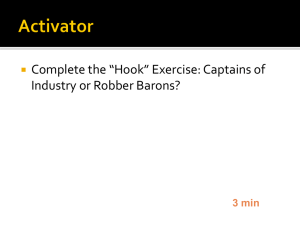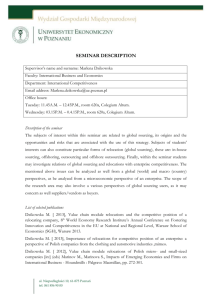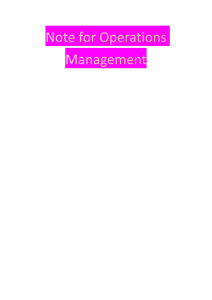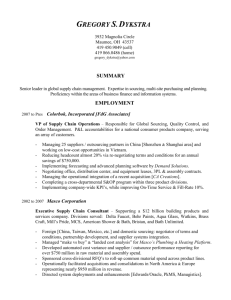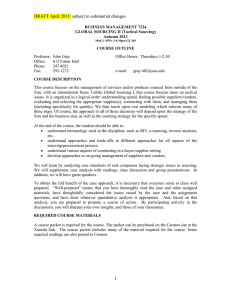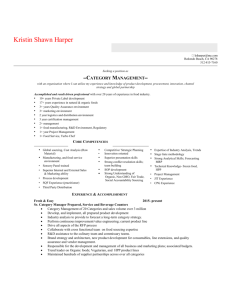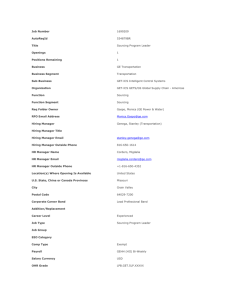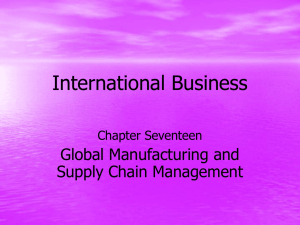www.LionTutors.com
advertisement
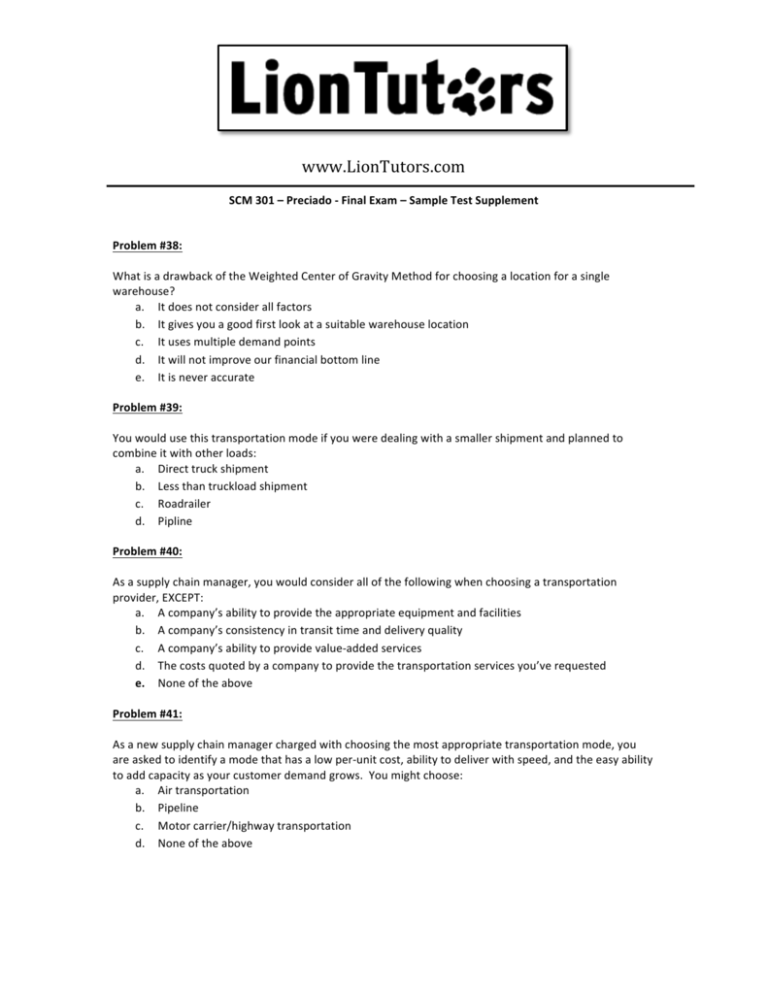
www.LionTutors.com SCM 301 – Preciado -­‐ Final Exam – Sample Test Supplement Problem #38: What is a drawback of the Weighted Center of Gravity Method for choosing a location for a single warehouse? a. It does not consider all factors b. It gives you a good first look at a suitable warehouse location c. It uses multiple demand points d. It will not improve our financial bottom line e. It is never accurate Problem #39: You would use this transportation mode if you were dealing with a smaller shipment and planned to combine it with other loads: a. Direct truck shipment b. Less than truckload shipment c. Roadrailer d. Pipline Problem #40: As a supply chain manager, you would consider all of the following when choosing a transportation provider, EXCEPT: a. A company’s ability to provide the appropriate equipment and facilities b. A company’s consistency in transit time and delivery quality c. A company’s ability to provide value-­‐added services d. The costs quoted by a company to provide the transportation services you’ve requested e. None of the above Problem #41: As a new supply chain manager charged with choosing the most appropriate transportation mode, you are asked to identify a mode that has a low per-­‐unit cost, ability to deliver with speed, and the easy ability to add capacity as your customer demand grows. You might choose: a. Air transportation b. Pipeline c. Motor carrier/highway transportation d. None of the above Problem #42: Your boss has tasked you with calculating the DPMO as part of implementation of the Six Sigma Methodology. What are you being asked to calculate? a. The weighted point average b. Landed costs c. The center-­‐of-­‐gravity method d. The number of defective products out of each million products created e. None of the above Problem #43: If your boss tells you to embrace the idea of continuous improvement, what are your aims likely to be? a. A complete and immediate overhaul of the supply chain b. Identifying and implementing incremental improvements that contribute to larger performance improvements over a longer period of time c. To keep things just as they are, because they are probably good enough d. To hire a new team to manage the supply chain Problem #44: You are looking at sourcing products that fall into the bottleneck quadrant. What might your best strategy be? a. Carry extra inventory to ensure supply continuity b. Relax and bargain for lower prices; this is the ideal situation for you as a buyer c. Attempt to adjust your need so you can increase the number of suppliers available to you d. Use Electronic Data Interchange e. Both A and C Problem #45: You are looking at sourcing products that fall into the leverage quadrant. What might your best strategy be? a. Carry extra inventory to ensure supply continuity b. Bargain for lower prices; this is an ideal situation for you as a buyer c. Attempt to adjust your need so you can increase the number of suppliers available to you d. Use Electronic Data Interchange e. Both A and C Problem #46: You are identifying potential suppliers for your product. You have identified 2 suppliers with very close scores on the weighted point evaluation system. You are also concerned about “putting all your eggs in one basket” and increasing your risk. You might address your concerns about risk by: a. Going with a single sourcing option b. Going with a cross sourcing option c. Going with a dual sourcing option d. Using vertical integration e. Using virtual integration Problem #47: Your manager asks you to calculate the total landed cost. What would you include in your calculation? a. Cost of your product b. Transportation costs c. Warehousing costs d. Customs fee e. All of the above Problem #48: Deming held a holistic view of responsibility for quality variability as a source of most problems. He proposed we apply the Deming Cycle, which instructs us to: a. Broaden our definition of quality b. Employ the Plan-­‐Do-­‐Check-­‐Act method c. Use the Kaizen system of continuous improvement d. Focus only on incremental change e. None of the above Problem #49: You can calculate the total cost of quality curve by adding: a. Internal failure costs b. External failure costs c. Prevention costs d. Appraisal costs e. All of the above f. Only B, C, and D www.LionTutors.com SCM 301 – Preciado – Final Exam – Answer Key 38. A 39. B 40. E; None of the above; these are all factors to consider when choosing a transportation supplier for your supply chain 41. C 42. D 43. B 44. E 45. B 46. C; dual sourcing enables you to spread your inventory order between 2 highly-­‐rated suppliers and spread your risk between them. You might choose a 70%/30% split and modify your order based on each supplier’s performance. 47. E; you have to consider all of the logistics-­‐related costs in addition to the cost of your product when calculating the landed cost 48. B; Employ the Plan-­‐Do-­‐Check-­‐Act method 49. E; you need to look at all these costs when determining your cost of quality curve
